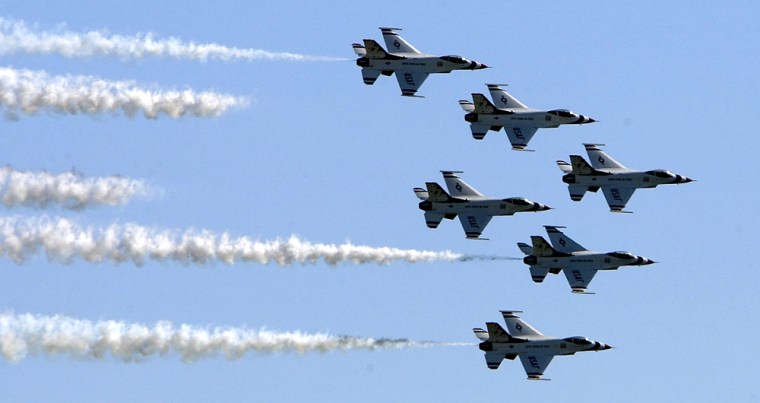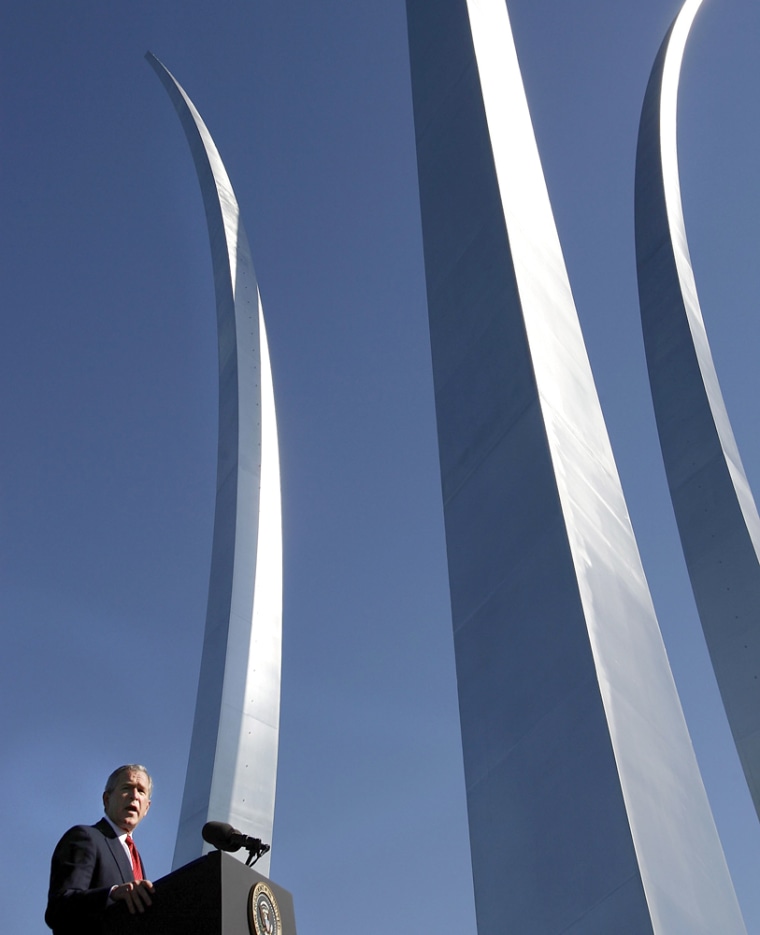President Bush helped the Air Force make a dream come true on Saturday, dedicating a hilltop monument for the service to the memory of airmen lost defending America and to those that fight for it still.
"A long blue line of heroes has defended freedom in the skies above," Bush said. "To all who have climbed sunward and chased the shouting wind, America stops to say your service and sacrifice will be remembered forever and honored in this place by the citizens of a free and grateful nation."
Bush spoke at the base of three soaring steel stalks, meant to evoke the famed Air Force Thunderbirds' "bomb-burst" maneuver, that glinted in the bright sun.
The dedication ceremony concluded with a dramatic demonstration of the real thing by members of the precision flying team. Their four jets flew straight upward in close formation and released silver contrails as they peeled away from each other. A fifth plane followed, flying through the middle of the vapors while spinning.
The $30 million United States Air Force Memorial, 15 years in the making, is set on a ridge next to Arlington National Cemetery and overlooking the Pentagon and the nation's capital beyond.
‘We pay tribute’
"Under these magnificent spires, we pay tribute to the men and women of the Air Force who stand ready to give all to their country," the president said. "And looking from this promontory to a place once filled with smoke and flames, we remember why we need them."
As the Air Force's history was recounted by a series of speakers, a succession of aircraft — from a replica of Orville Wright's historic biplane to an F-117A Nighthawk Stealth fighter — flew overhead.
The 17,000-ton metal spires that are the centerpiece of the memorial arc as high as 270 feet into the air.
"This memorial soars. It soars in space and in the imagination," Air Force Secretary Michael Wynne said. "These three spires echo our values: integrity, service and excellence. ... This memorial is a brilliant symbol of freedom and the spirit of flight."
Nearby are also two inscribed granite walls and an 8-foot bronze "honor guard" statue of four figures. A glass wall engraved with the "missing man" formation — a signature maneuver to honor those missing and fallen in the military — provides the only images of aircraft.

"This memorial says to everybody who visits, today and tomorrow, 'This is the spirit that helped build the Air Force. This is the sacrifice that helped defend our freedom. This is the courage that helped build our nation.' On behalf of a very grateful country, and a grateful people, it says, 'Thank you,'" said H. Ross Perot, Jr., chairman of the memorial's board of trustees and a former fighter pilot in the Air Force Reserve.
The memorial was the last major work of architect James Ingo Freed, who died in December. Among his other projects is the U.S. Holocaust Memorial Museum in Washington.
The Air Force was the only military branch without a monument around the capital. Efforts to change that, though, were stymied by controversy, lawsuits and congressional action until the current site and design went forward.
The memorial was first planned for a spot on the other side of Arlington National Cemetery, and Freed's design of a suspended five-pointed star won the competition in the mid-1990s. But the Marines disputed the location, saying it encroached on their cherished Iwo Jima Memorial nearby.
Lawsuits ensued and legislation was passed to prevent construction. Eventually, a new site was donated and the designing process had to start over. Freed won again with a design said to be inspired after the architect saw the Thunderbirds on television.
The design has been trumpeted for its modern appeal and its reflection of the Air Force's advanced technology.
